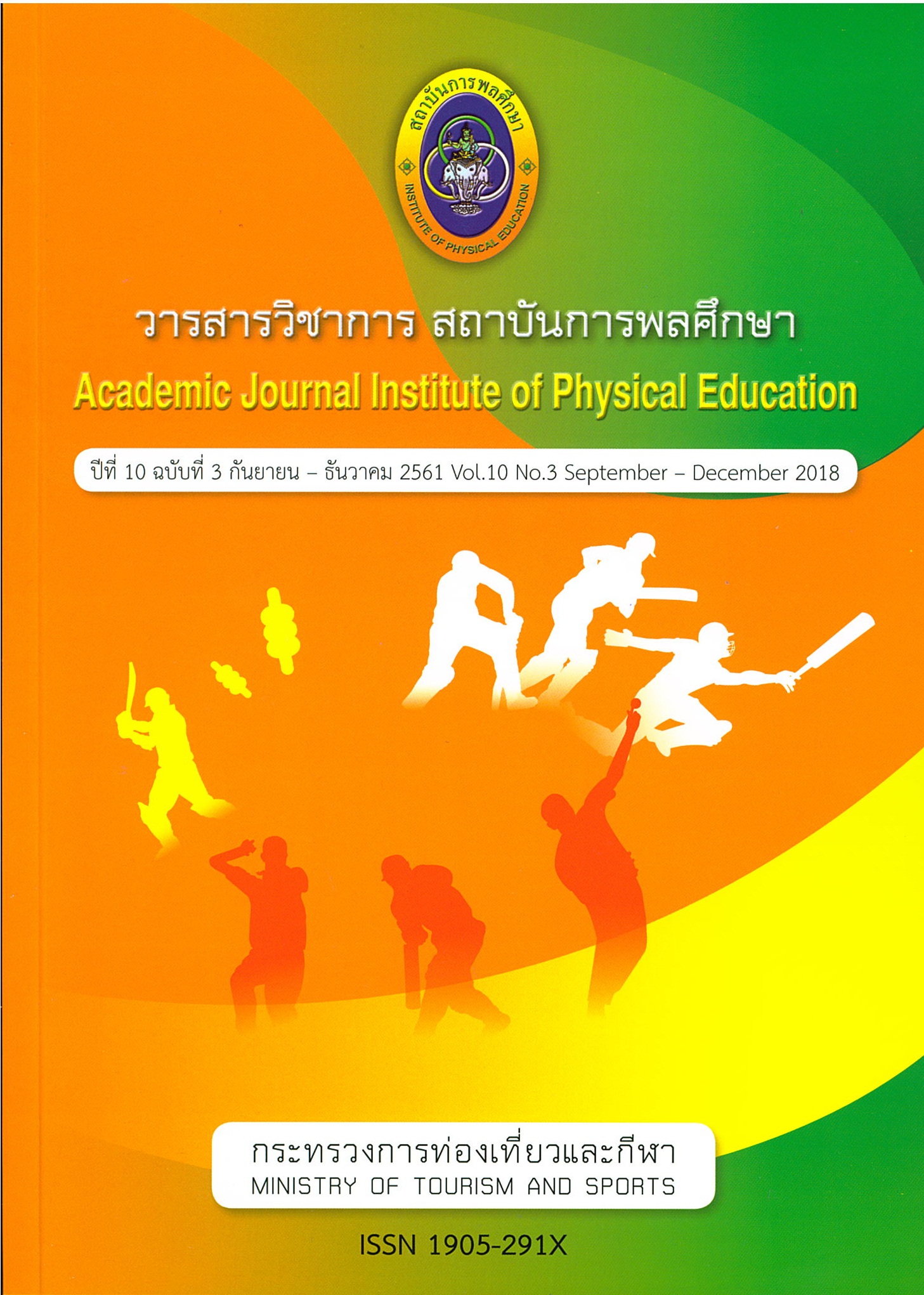The Measure of Physical and Psychological States for Sport Injury in Thai Athletes
Main Article Content
Abstract
This study aimed to study and compare the physical and psychological states for sport injury in Thai athletes classified by gender. Participants were 248 Thai athletes who got sport injured (male = 162, female = 86), age ranging between 18–21 years old, from 23 sports. Purposive sampling was used to particularly select the sport injured athletes to participate in this study. Equipment used in this study was the Measure of Physical and Psychological States for Sport Injury (MPPSSI) developed form the Measure of Physical and Psychological States in Sports, Bhasavanija, Cherathammawat, Chobthamasakul, & Poompin, 2015). The Intraclass Correlation Cronbach’s Alpha reliability value was 0.81 and the apart-7-day test-retest reliability value was 0.69 analysed by using the Pearson’s Product Moment Correlation Coefficient. This measure consists of five components and 18 subscales: quality of life, confidence, anxiety, perception of pain, and perception of
muscle tension. Mean, Standard Deviation, and t-test for Independent were used mention the results.
Results were;
Studying the physical and psychological states for sport injury in injured athletes was that overall mean was moderate level ( = 2.49, S.D. = 1.18) in which the 1st sport injury component was the Quality of Life (positive) overall as much level (
= 2.72, S.D. = .90), and the last component was the Perception of Pain (negative) overall as less level (
= 2.72, S.D. = 1.05). Comparison of physical and psychological states for sport injury between male and female injured athletes in all components had no statistical difference (t = 1.07, p = .28) among 18 subscales, however, when the mean of each subscale was examined found that the male overall mean (
= 2.44, S.D. = .51) was higher than of females (
= 2.36, S.D. = .46) for all components, except that females (
= 2.48, S.D. = .59) had higher the Confidence level than males (
= 2.39, S.D. = .76).
Article Details
The published article is a copyright of the Academic Journal of Thailand National Sports University. The passage appeared in each article in this academic journal is a perspective of each author which is not related to the journal. Each author is required to be responsible for all components of his/her own article. If there are any mistakes, each author must be responsible for those mistakes on his/her own.
References
การกีฬาแห่งประเทศไทย. (2559). ทะเบียนนักกีฬา. http://www2.sat.or.th/sportmanregis/sportRegis.asp
ธิรตา ภาสะวณิช. (2559). จิตวิทยาการกีฬาPED4303. กรงุเทพมหานคร: โรงพิมพ์มหาวิทยาลัยรามคำแหง
Bell, R.J. & Thompson, C.L. (2007). Solution-focused guided imagery for a golfer experiencing the yips: A case study. Athletic Insight, 9(1), p.4.
Bhasavanija, T. (2014). Comparison of body temperature, oxygen saturation, and heart rate among rest, practice, stretch, and imagery in youth Takraw athletes. Proceedings: The 10th International Sport Sciences Conference. Kota Bharu, Kelantan, Malaysia: ISSC. p.12.
Bhasavanija, T., Chirathamawat, P., Chobthamasakul, C., & Poompin, K. (2015). Validation of the Physical and Psychological State Measure in Sport for Thai athletes. Proceedings: The 2nd International Seminar in Exercise and Sport Psychology. Burapha University, Thailand: ISESP, p.34.
Bhasavanija, T., & Kuan, G. (2017). The effectof warmth imagery on physiological, physical and psychological states among injured youth sepaktakraw athletes: A case study design. International Journal of Sport, Exercise and Health Research, 1(1), pp.35-40.
Bhasavanija, T., & Morris, T. (2013). Using imagery of warmth in competition for oxygen consumption and golf putting performance enhancement. Proceedings: The 13th World Congress of Sport Psychology.Beijing, China: ISSP, p.32. http://ucha.blogia.com/2013/062904-the-issp-13th-world-congress-of-sport-psychology.php.
Bhasavanija, T. & Morris, T. (2014). Imagery: Chapter 23, Part4. In A.G. Papaioannou & Hackfort, D. Routledge Companion to Sport and Exercise Psychology: Global perspectives and fundamental concepts. New York: Routledge, pp.356-371.
Brewer, B.W., Cornelius, A.E., Van Raalte, J.L., Brickner, J.C., Sklar, J.H., Corsett, J.R. et al. (2004). Rehabilitation adherence and anterior cruciate ligament outcome. Psychology. Health and Medicine, 9, pp.163-175.
Chottidao, M., & Limroongreungrat, W. (2015). The study of Thai’s fencers injuries in 38th national sport competition at Trang. Retrieved June, 6, 2017 from https://www.researchgate.net/publication/280545207.


